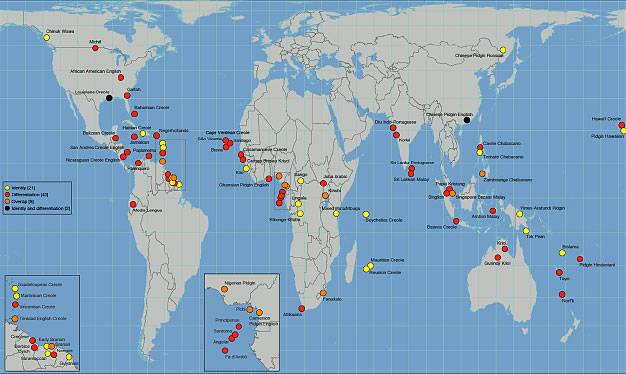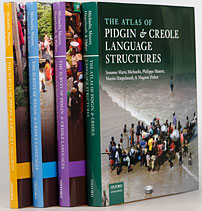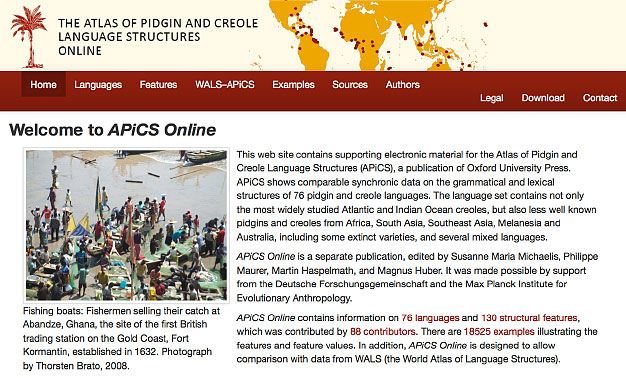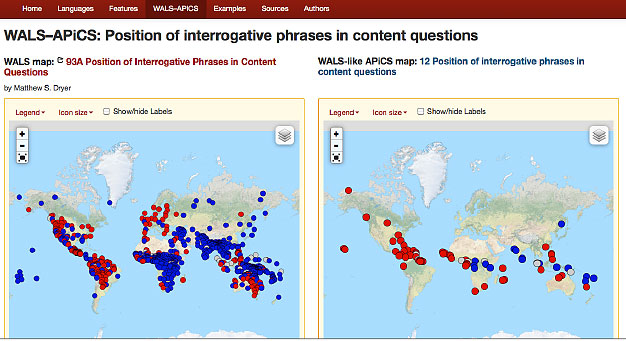Project Members
- Susanne Maria Michaelis
- Martin Haspelmath
- Magnus Huber (University of Gießen)
- Philippe Maurer (University of Zurich)
- Bradley Taylor
- Robert Forkel
Atlas of Pidgin and Creole Language Structures (APiCS)

APiCS (The atlas of pidgin and creole language structures) has gathered comparable synchronic data on the grammatical and lexical structures of a large number of pidgin and creole languages. It has been published in four volumes (September 2013):
- Michaelis, Susanne Maria, Maurer, Philippe, Haspelmath, Martin & Huber, Magnus (eds.). The atlas of pidgin and creole language structures. Oxford: Oxford University Press.
- Michaelis, Susanne Maria, Maurer, Philippe, Haspelmath, Martin & Huber, Magnus (eds.). The survey of pidgin and creole languages, Volumes 1-3. Oxford: Oxford University Press.

In the first volume, the Atlas volume, the data are presented in the form of maps. The other three survey volumes contain sociohistorical and grammatical surveys of each language.
The underlying database to the project, APiCS Online has been published as a freely available online version with the Max Planck Institute for Evolutionary Anthropology (November 2013).
Michaelis, Susanne Maria, Maurer, Philippe, Haspelmath, Martin & Huber, Magnus (eds.). The Atlas of Pidgin and Creole Language Structures Online. Leipzig: Max Planck Institute for Evolutionary Anthropology. Online available.

The project covers 76 pidgin and creole languages. The language set contains not only the most widely studied Atlantic and Indian Ocean creoles, but also less well known pidgins and creoles from Africa, South Asia, Southeast Asia, Melanesia and Australia, including some extinct varieties, as well as a few mixed languages.
The database consists of 130 structural features which are drawn from all areas of grammar: phonology, morphology, syntax and lexicon. A feature has between two and nine values, shown on the maps by different colours and shapes of the language symbols. APiCS Online includes map display and various filtering and search functions, allowing users to address various research questions. Furthermore, APiCS Online includes sound files of every language, enabling the users to listen to a short text that is glossed and translated. APiCS Online also contains references for each datapoint, as well as a large number of fully glossed examples, often from naturally occurring texts. There is also additional information on phonological segments and sociolinguistic features. (The Atlas book in addition contains text chapters for each of the 130 features, written by the editors, as in WALS. These text chapters are not available online). The APiCS Online application was developed by Robert Forkel as part of the CLLD project.
Each language is the responsibility of a single author or a team of authors, which were requested to fill out a questionnaire for the 130 structural features and to write a sociohistorical and grammatical survey article for their language.
The presentation of the data in map form has two goals. On the one hand, maps are more easily accessible to students and lay persons who have a general interest in contact languages, but who would be less likely to pay attention to data presented as tables with numbers. On the other hand, the properties of contact languages are often dependent on their geographical distribution, as similar contact languages are often spoken next to each other. Since pidgins and creoles are not distributed equally around the world, and because some areas, such as the Caribbean, have a high density of creoles, the main world map of each feature will be accompanied by blow-up maps showing certain areas in detail.
The three survey volumes contain concise prose descriptions of the sociohistorical context of each language, as well as synchronic grammatical surveys highlighting the major distinguishing features.
The four-volume publication (plus APiCS Online) is a comprehensive and authoritative reference work on pidgin and creole language structures bringing together the expertise of dozens of specialists from around the world. APiCS thus serves as an invaluable tool for teaching and research, making systematic data on these languages readily available for a wide range of research questions (theories of creolization, uniformity and diversity of creoles, general properties of language contact, typological characteristics of contact languages).
APiCS was inspired by the World Atlas of Language Structures (WALS), which shows the geographical distribution of 142 features in an average of 400 languages world-wide. Pidgins and creoles were not completely excluded from WALS, but since the primary goal was to present the precolonial linguistic areas, pidgins and creoles were backgrounded. APiCS contains 48 features on which information is also available in WALS, so that creoles and pidgins can readily be compared with their substrate and superstrate languages, as well as with the world's languages in general. However, APiCS does not copy WALS blindly, but adds many features that did not make it into WALS but are important for contact languages. Other features that appear in WALS have been modified to suit the needs of the APiCS users.
